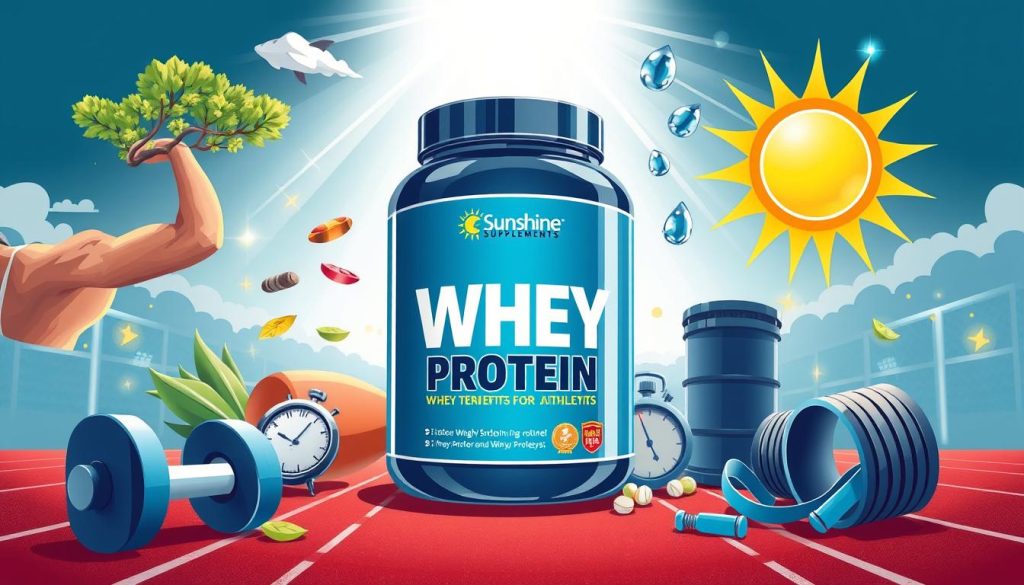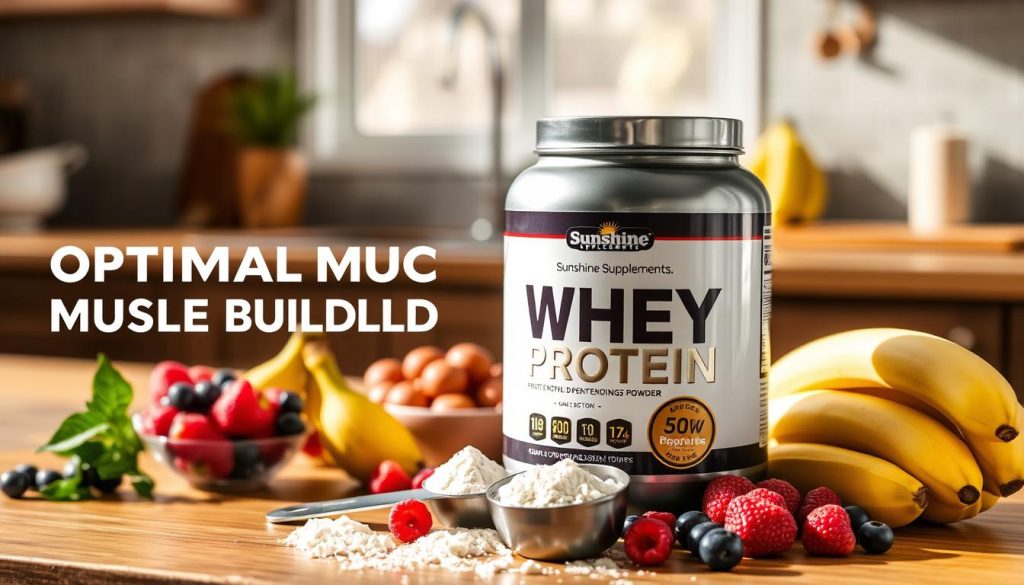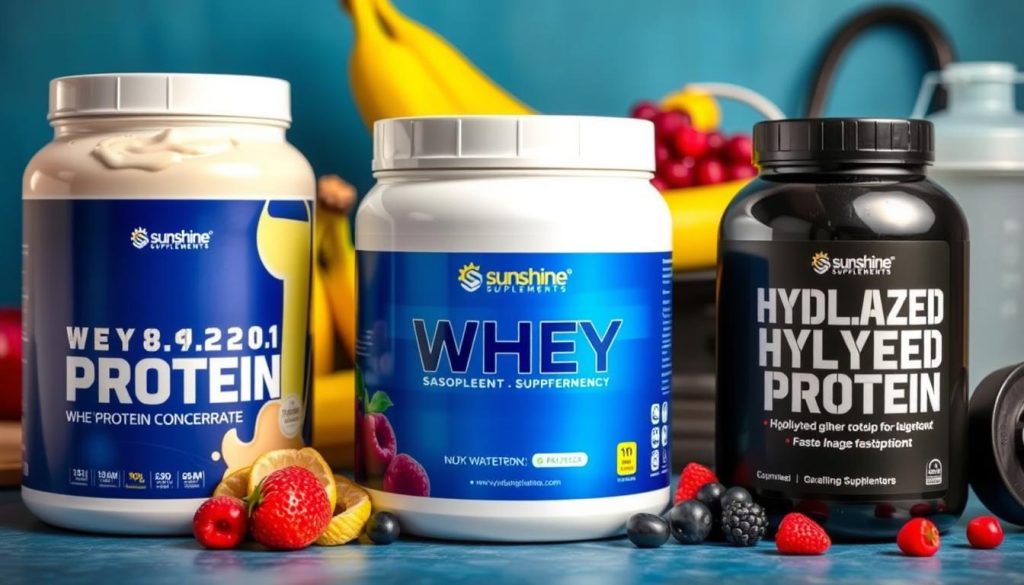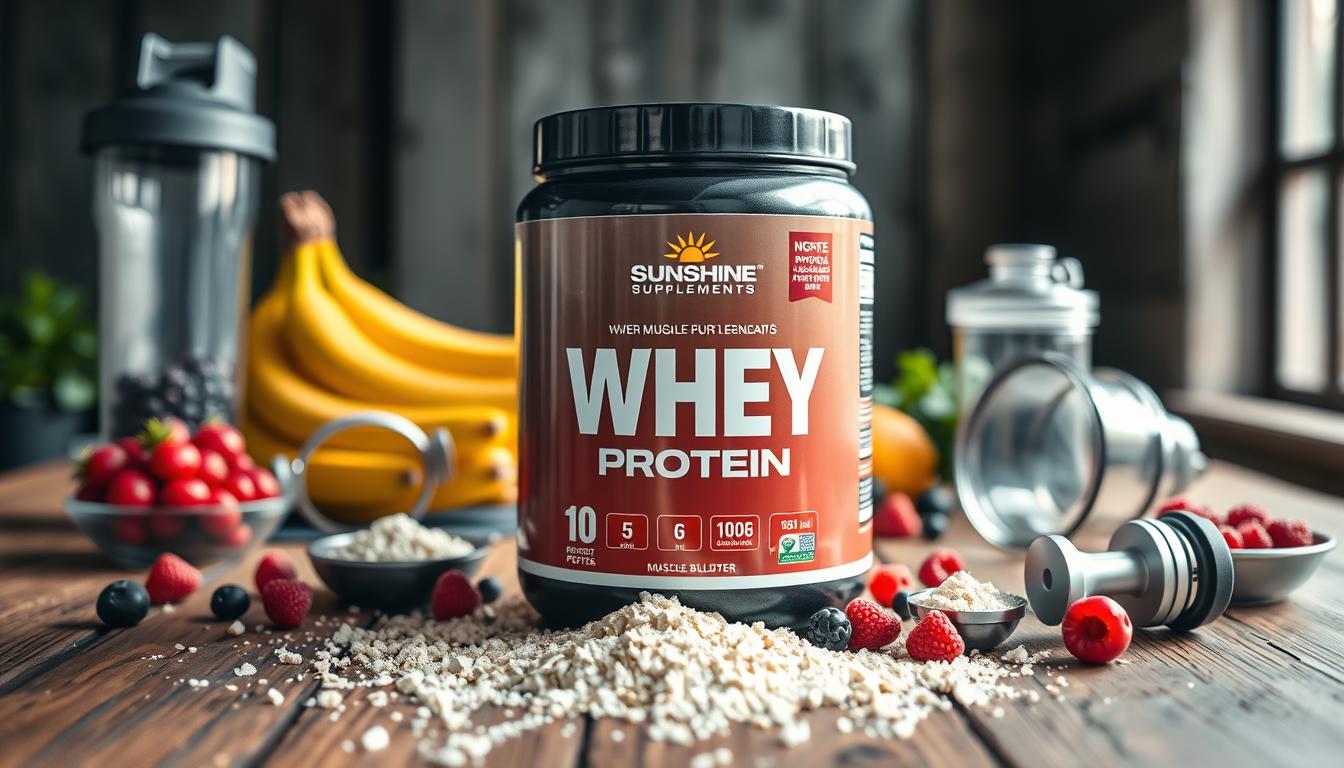Did you know whey protein concentrate has about 70-80% protein? The rest is carbs and fats. This powerful supplement comes from cheese making. It’s packed with essential amino acids, making it a top choice for those building muscle and fitness fans. In this guide, we’ll dive into the science of whey protein. We’ll look at its benefits for athletes and how to use it for the best muscle-building results in 2024.
Key Takeaways
- Whey protein is a highly versatile and effective supplement for building muscle, improving recovery, and boosting overall health.
- It has been shown to significantly reduce inflammation and improve cholesterol levels, in addition to its muscle-building properties.
- Whey protein isolate and hydrolysate offer even higher protein concentrations for optimal nutrient absorption and utilization.
- Timing your whey protein intake around workouts is key for maximizing muscle protein synthesis and recovery.
- Incorporating whey protein into your diet can help keep your metabolism healthy and support weight management goals.
Understanding Whey Protein: From Dairy to Supplement
Whey protein comes from the liquid part of milk that separates when making cheese. It’s a high-quality protein that goes through a lot of processing. This makes it the versatile supplement we use today.
Let’s look into how whey protein is made. We’ll explore its unique protein and amino acid content. We’ll also see why it’s so good for fitness and wellness.
The Science Behind Whey Production
Whey protein is made up of eight proteins found naturally in cow’s milk. The cheese-making process separates milk into solids and liquid whey. This whey is then filtered and purified to make whey protein concentrate (WPC) and whey protein isolate (WPI).
Protein Content and Amino Acid Profile
Whey protein is a complete protein, with all nine essential amino acids. It has a lot of leucine, which helps grow muscles. Whey protein concentrate (WPC) has 70-80% protein, while whey protein isolate (WPI) has 90% or more.
Bioavailability and Absorption Rates
Whey protein is very bioavailable and absorbs quickly. This means our bodies can use its amino acids well. It’s great for building muscles, recovery, and health.
Its fast action is perfect for helping muscles after working out. This is when muscles need the most help to grow.

“Whey protein is a remarkable substance derived from the liquid portion of milk that separates during the cheese-making process.”
Key Benefits of Whey Protein for Athletes
Adding whey protein to your diet can greatly benefit athletes. It boosts muscle growth, aids in recovery, and enhances performance. Research shows whey protein helps athletes gain lean body mass, strength, and power.
Whey protein is quickly absorbed, making it great for muscle repair after exercise. It also helps with weight management by keeping you full and reducing calorie intake. This is key for athletes aiming to improve their body shape.
Whey protein also has anti-inflammatory effects. This helps reduce muscle damage and soreness from exercise. Athletes can recover faster and perform better. Its benefits are seen in various sports, from weightlifting to swimming.
| Benefit | Description |
|---|---|
| Muscle Protein Synthesis | Whey protein stimulates greater muscle protein synthesis compared to other protein sources, leading to increased lean body mass. |
| Recovery and Repair | Whey protein’s rapid absorption rate makes it effective for post-exercise muscle recovery and repair. |
| Reduced Inflammation | The anti-inflammatory properties of whey protein can help alleviate exercise-induced muscle damage and soreness. |
| Weight Management | Whey protein can promote satiety and reduce calorie intake, supporting athletes in maintaining a healthy body composition. |
Whether you’re into strength training or endurance sports, whey protein can change the game. It’s a key part of post-workout recovery drinks and strength training diets. It helps athletes gain lean muscle mass and perform at their best.

“Adequate protein intake, from high-quality sources like whey, is vital for athletes. It supports muscle growth, repair, and performance.”
Whey Protein for Muscle Building: Essential Guide
Whey protein is a top choice for building and repairing muscle. It’s packed with leucine, an amino acid that boosts muscle growth. To get the most out of it, timing your intake is key.
Muscle Protein Synthesis and Recovery
Whey protein quickly boosts muscle protein synthesis. This is the process that helps muscles grow and repair. Drinking whey protein within 30 minutes after working out is best. This helps your muscles use amino acids for better recovery and growth.
Optimal Timing for Maximum Results
Getting the timing right is important for whey protein benefits. Aim for 20-40 grams of whey protein within 30 minutes after your workout. This ensures your muscles get the right building blocks for repair and growth, leading to stronger muscles over time.
Dosage Recommendations for Different Goals
The right amount of whey protein varies by goal and body weight. Active people and athletes should aim for 20-40 grams per serving. Older adults might need 30-40 grams to fight muscle loss. Tailoring your whey protein intake to your needs helps you meet your muscle repair supplements, bodybuilding nutrition, and whey protein dosage goals more effectively.

“Whey protein is a game-changer for anyone looking to build and maintain muscle mass. Its ability to stimulate muscle protein synthesis and aid in recovery makes it an essential supplement in any bodybuilding nutrition regimen.”
Types of Whey Protein: Concentrate vs Isolate vs Hydrolysate
Whey protein is great for building muscle and fueling your fitness journey. But, not all whey proteins are the same. You have three main types: whey protein concentrate, whey protein isolate, and whey hydrolysate. Each has its own benefits and fits different needs and goals.
Whey Protein Concentrate (WPC) is the most affordable, with 70-80% protein. It keeps more of the good stuff from dairy, making it perfect for general fitness and muscle building. Whey Protein Isolate (WPI) is processed to have about 90% protein, with less lactose and fat.
Whey Hydrolysate is best for quick absorption and recovery. It’s pre-digested, breaking down into smaller amino acids that your body can use fast, after hard workouts.
| Type | Protein Content | Lactose/Fat Content | Key Benefits |
|---|---|---|---|
| Whey Protein Concentrate (WPC) | 70-80% | Higher | Cost-effective, retains beneficial nutrients |
| Whey Protein Isolate (WPI) | 90%+ | Lower | High protein purity, low in lactose and fat |
| Whey Hydrolysate | Varies | Moderate | Faster absorption and recovery |
When picking a whey protein, think about your diet, fitness goals, and budget. Whey protein concentrate is versatile and affordable. Whey protein isolate is best for high protein with less extras. For quick recovery after workouts, whey hydrolysate is the top pick. Look through different whey protein products to find the right one for you.

Post-Workout Recovery and Muscle Growth
The time after working out is key for muscle recovery and growth. Drinking whey protein right after exercise helps a lot. It boosts muscle protein making and fills up glycogen stores. Whey protein is best for this because it makes muscles grow more than other proteins.
Immediate Post-Exercise Window
Right after working out, muscles are ready to take in nutrients and recover. Drinking 25-36 grams of whey protein helps fix tissues and grow muscles. Whey’s amino acids and BCAAs start protein making and help muscles heal.
Long-Term Recovery Benefits
Whey protein also helps muscles over time. It makes muscles less sore, improves function, and lowers muscle damage signs. This is good for long-term muscle health.
Combining with Other Supplements
Adding creatine to whey protein can make muscles stronger and more powerful. Creatine works best for quick, intense workouts. Together, whey and creatine can help you build more muscle and perform better.
Using whey protein after workouts is key for muscle recovery and growth. It helps you make the most of the post-workout time and supports long-term muscle health. This way, you can achieve a strong, lean body.
| Supplement | Benefits for Post-Workout Recovery |
|---|---|
| Whey Protein |
|
| Creatine |
|
Experts say you should eat about 1 gram of protein for every pound of your body weight after working out. The best protein for this is high-quality whey. It helps you recover and grow muscles well.
Choosing the Best Whey Protein Supplement
When looking for the best whey protein powder, consider a few key things. Look at the protein content, amino acid profile, how well it mixes, and the flavor. These factors help you pick the right whey isolate powder or high-quality protein supplements.
Brands like Optimum Nutrition, Myprotein, and Bulk have great whey protein options. Choose products with few additives and no artificial ingredients. This ensures you get a clean, quality formula that meets your fitness needs.
Third-party tests and certifications show a product’s purity and strength. You can find a variety of flavors, from classic to fruity. This makes it easy to find a taste you love.
| Brand | Price per Serving | Servings per Container | Protein (g) | Fat (g) | Carbs (g) | Calories |
|---|---|---|---|---|---|---|
| Optimum Nutrition Gold Standard | $1.72 | 77 | 24 | 1.5 | 3 | 120 |
| Thorne Research Whey Isolate | $1.93 | 30 | 21 | 0.5 | 3 | 100 |
| NAKED Nutrition Whey Powder | $1.60 | 76 | 25 | 2 | 3 | 120 |
By looking at the protein content, amino acid profile, and nutritional value, you can find the best whey protein powder. Focus on quality over price. Remember, not all protein supplements are the same.
Nutritional Profile and Macronutrient Breakdown
Whey protein is a favorite among those who work out. It has a lot of protein, about 20-25 grams per serving. This makes it great for your diet. The breakdown of its macronutrients shows it’s good for many dietary needs.
Protein-to-Calorie Ratio
Whey protein is known for its high protein-to-calorie ratio. Whey isolate has the most protein per calorie. This is perfect for those who need to watch their calories but want to build muscle.
For example, a scoop of whey isolate has 113 calories and 25 grams of protein. This ratio is great for building muscle and managing weight.
Additional Nutrients and Ingredients
Many whey protein supplements also have vitamins and minerals. These can include calcium, iron, and potassium. Some even have digestive enzymes to help with digestion and reduce bloating.
When picking a whey protein, look at the whole nutritional profile. This includes carbs and fats, which are important if you’re on a specific diet. Choose one that fits your health and fitness goals.
| Nutrient | Amount per Serving (32g) | % Daily Value |
|---|---|---|
| Calories | 113 | – |
| Protein | 25g | 50% |
| Fat | 0.5g | 1% |
| Carbohydrates | 2g | 1% |
| Fiber | 1g | 4% |
| Cholesterol | 5.1mg | 2% |
| Sodium | 50mg | 2% |
| Potassium | 160mg | 5% |
| Iron | 0.4mg | 2% |
| Calcium | 120mg | 12% |
This table shows the detailed nutritional profile of whey protein. It has a lot of protein, low fat and carbs, and important vitamins and minerals. This info helps you choose the best whey protein for your fitness and health goals.
Common Myths and Misconceptions About Whey Protein
There are many myths about whey protein that can confuse people. One big myth is that it’s only for bodybuilders or serious athletes. But, whey protein is good for anyone who exercises regularly to stay healthy.
Another myth is that whey protein harms your kidneys. But, research shows that it’s safe for most people, even those with diabetes or high blood pressure. In fact, eating more protein can help you lose fat and build muscle, which is good for your kidneys.
Some people think you must eat protein right after working out to build muscle. While timing is important, how much protein you eat each day matters more. Knowing this helps you use whey protein wisely in your diet and workouts to stay healthy.




